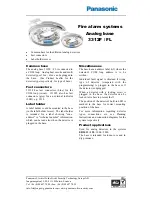
TECHNICAL
SPECIFICATIONS
REGULATORY
APPROVALS
The fi re systems help half of residents escape. Help
to old people, men, women and children shall be given
since they are always the victims.
Smoke alarms detectors are not foolproof, they can’t
prevent or extinguish fi res, and they are not a substi-
tute for property or life insurance. You need buy some
fi refi ghting facilities.
Sometimes the smoke is blocked by objects and can’t
reach the detector, and if the wind blows the smoke
away from the detector, the unit won’t work either.
LIMITATIONS
MUTING AN ALARM
The sound alert of the UN-WSM_RND could be muted
for fi ve minutes. After fi ve minutes, if the
UN-WSM_RND continues to detect smoke, the alarm
resumes. To mute the alarm, press the TEST/MUTE
button.
Detection method:
Photoelectric smoke chamber
Data Protocol
UN-RF 2-way
Modulation Type
GFSK with 5 frequency & LBT
Frequency
868MHz
Transmit Power (Typ.) 23dBm
Events Transmission Alarm, Tamper, Supervision,
Battery
status
Detection Sensitivity: 2.3+1.2%/ft
Alarm Sound Level:
≥85 db at 3 m
Range in open space >500m
Batteries
Pack of 2 Lithium 1.5V,
Size:
AA
Batteries Model
Energizer L91
Battery life expectancy ≥ 2 years
Current Consumptions:
•
Standby
5mA (Keep Alive every 7min)
•
Alarm
~400 mA
•
Low Battery
~2.5VDC
•
Cut Off Batery ~2.3VDC
Tamper Switch Bracker removal
Operating
-10°C to +50°C
temperature
Dimensions
125mm diameter x
38mm
deep
Weight (inc. battery) 235 gr.
The UN-WSM_RND conforms to the essential
requirements set out by:
•
EMC directive:1999/05/EC
•
LVD directive: 2014/35/EU
•
RoHS2 directive: 2011/65/EU
Harmonized Standards applicable to these products
are:
•
EN 301 489-6: V1.4.1(15)
•
EN 301 489-1: V1.9.2(11)
•
EN 60950-1:2006 / A11(09) / A1(10) / A12(11)/
A2(13)
•
IEC60950-1:2005/A1(09)/A2(13)
•
EN 14604:2005/A1(08)
WARNING
1. Never use an open fl ame of any kind to test your
detector. You may set fi re to damage the detector as
well as your home. The built-in test button
accurately tests all detector functions. This is the
only correct way to test the unit.
2. To stop a nuisance alarm, open a window or fan
the air around the detector to get rid of the smoke.
The alarm will turn itself off when the smoke is gone.
If nuisance alarms persist, attempt to clean the
detector as described in this manual.
3. Do not stand close to the detector when the alarm
is sounding. The alarm is loud in order to wake you
up in an emergency. Too much exposure to the horn
at close range may be harmful to your hearing.
4. Never try to avoid false alarms by disabling the
detector.
WARNING
WARNING
5. Dust can damage the smoke detector’s sensitivity.
The detector needs to be cleaned at least once a
year as described in this manual.
6. If the alarm horn produces a loud continuous
sound when you are not testing the unit, this means
the detector has sensed smoke or combustion
particles in the air. Verify that the alarm is a result
of a possible serious situation, which requires your
immediate attention.
7. The alarm could be caused by a nuisance situa-
tion. Cooking smoke or a dusty furnace, sometimes
called “friendly fi res” can cause the alarm to sound.
If this happens, open a window or fan the air away to
remove the smoke or dust. The alarm will turn off as
soon as the air is completely clear.
8. This smoke detector is designed for use in a
single residential unit or small buildings only, which
means that it should be used inside a single-family
home, apartment or small buildings. Smoke detec-
tors, placed in common areas outside the individual
living unit, such as on porches or in hallways, may
not provide early warning to residents.
9. This smoke detector, if used as a stand-alone unit,
will not alert people who are hard of hearing.
10. Changes or modifi cations to this equipment
not expressly approved by the party responsible for
compliance (Crow Electronic Engineering Ltd.) could
void the user’s authority to operate the equipment.
11. Batteries of this device are not replaceable. Re-
commanded date for device replacement ≥2 years
from fi rst operation date.
DETECTOR TESTING
After the learning process and installing the
smoke detector, we recommend performing and
transmission tests.
Alarm Test
Press shortly the “Test” button (see fi g. 2) - the smoke
detector shall activate 3 beeps and Green LED,
indicating that the device is in the normal mode.
If the test fails, stop using the detector immediately.
WARNING – DON’T TEST IT WITH FIRE !!!
Tamper Transmission Test
Removing the smoke detector from its bracket will
cause tamper transmissions.
Verify the UNii keypad (info) indicates “Tamper”. Verify
receiving the indication in the UNii manager software,
by entering to the diagnostics menu.
Communication signal test
Check the RF Communication quality. Special
indication at the UNii keypad that displays
continuously the received RF signal quality.
Never use water, cleaners or solvents to clean your
Smoke detector since they may damage the unit. Use
a soft brush only. Remove the device from its bracket
(by turn it counter clock wise) and carefully remove
any dust from the Smoke’s openings around the
device (see below fi gure) at least once a year.
REGULAR MAINTENANCE
/ CLEANING
OPENINGS




















